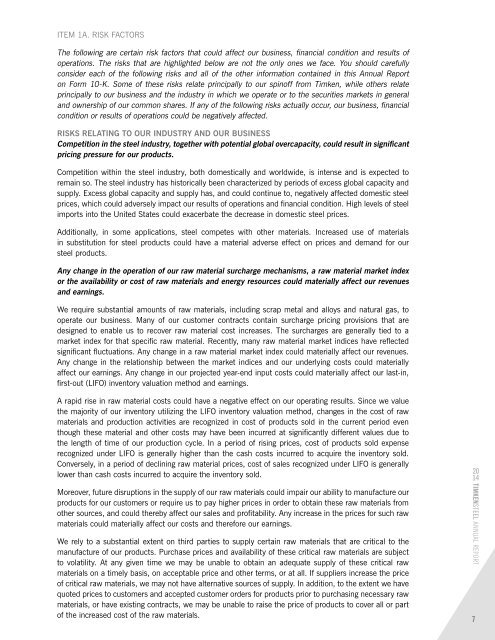TimkenSteel-2014-Annual-Report-FINAL-03112015_v001_d4t4ig
TimkenSteel-2014-Annual-Report-FINAL-03112015_v001_d4t4ig
TimkenSteel-2014-Annual-Report-FINAL-03112015_v001_d4t4ig
Create successful ePaper yourself
Turn your PDF publications into a flip-book with our unique Google optimized e-Paper software.
ITEM 1A. RISK FACTORS<br />
The following are certain risk factors that could affect our business, financial condition and results of<br />
operations. The risks that are highlighted below are not the only ones we face. You should carefully<br />
consider each of the following risks and all of the other information contained in this <strong>Annual</strong> <strong>Report</strong><br />
on Form 10-K. Some of these risks relate principally to our spinoff from Timken, while others relate<br />
principally to our business and the industry in which we operate or to the securities markets in general<br />
and ownership of our common shares. If any of the following risks actually occur, our business, financial<br />
condition or results of operations could be negatively affected.<br />
RISKS RELATING TO OUR INDUSTRY AND OUR BUSINESS<br />
Competition in the steel industry, together with potential global overcapacity, could result in significant<br />
pricing pressure for our products.<br />
Competition within the steel industry, both domestically and worldwide, is intense and is expected to<br />
remain so. The steel industry has historically been characterized by periods of excess global capacity and<br />
supply. Excess global capacity and supply has, and could continue to, negatively affected domestic steel<br />
prices, which could adversely impact our results of operations and financial condition. High levels of steel<br />
imports into the United States could exacerbate the decrease in domestic steel prices.<br />
Additionally, in some applications, steel competes with other materials. Increased use of materials<br />
in substitution for steel products could have a material adverse effect on prices and demand for our<br />
steel products.<br />
Any change in the operation of our raw material surcharge mechanisms, a raw material market index<br />
or the availability or cost of raw materials and energy resources could materially affect our revenues<br />
and earnings.<br />
We require substantial amounts of raw materials, including scrap metal and alloys and natural gas, to<br />
operate our business. Many of our customer contracts contain surcharge pricing provisions that are<br />
designed to enable us to recover raw material cost increases. The surcharges are generally tied to a<br />
market index for that specific raw material. Recently, many raw material market indices have reflected<br />
significant fluctuations. Any change in a raw material market index could materially affect our revenues.<br />
Any change in the relationship between the market indices and our underlying costs could materially<br />
affect our earnings. Any change in our projected year-end input costs could materially affect our last-in,<br />
first-out (LIFO) inventory valuation method and earnings.<br />
A rapid rise in raw material costs could have a negative effect on our operating results. Since we value<br />
the majority of our inventory utilizing the LIFO inventory valuation method, changes in the cost of raw<br />
materials and production activities are recognized in cost of products sold in the current period even<br />
though these material and other costs may have been incurred at significantly different values due to<br />
the length of time of our production cycle. In a period of rising prices, cost of products sold expense<br />
recognized under LIFO is generally higher than the cash costs incurred to acquire the inventory sold.<br />
Conversely, in a period of declining raw material prices, cost of sales recognized under LIFO is generally<br />
lower than cash costs incurred to acquire the inventory sold.<br />
Moreover, future disruptions in the supply of our raw materials could impair our ability to manufacture our<br />
products for our customers or require us to pay higher prices in order to obtain these raw materials from<br />
other sources, and could thereby affect our sales and profitability. Any increase in the prices for such raw<br />
materials could materially affect our costs and therefore our earnings.<br />
We rely to a substantial extent on third parties to supply certain raw materials that are critical to the<br />
manufacture of our products. Purchase prices and availability of these critical raw materials are subject<br />
to volatility. At any given time we may be unable to obtain an adequate supply of these critical raw<br />
materials on a timely basis, on acceptable price and other terms, or at all. If suppliers increase the price<br />
of critical raw materials, we may not have alternative sources of supply. In addition, to the extent we have<br />
quoted prices to customers and accepted customer orders for products prior to purchasing necessary raw<br />
materials, or have existing contracts, we may be unable to raise the price of products to cover all or part<br />
of the increased cost of the raw materials.<br />
20<br />
14<br />
TIMKENSTEEL ANNUAL REPORT<br />
7


